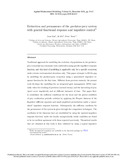- CERES Home
- →
- Cranfield Defence and Security
- →
- Staff publications (CDS)
- →
- View Item
JavaScript is disabled for your browser. Some features of this site may not work without it.
| dc.contributor.author | Liu, Juan | |
| dc.contributor.author | Hu, Jie | |
| dc.contributor.author | Yuen, Peter W. T. | |
| dc.date.accessioned | 2020-09-10T11:44:10Z | |
| dc.date.available | 2020-09-10T11:44:10Z | |
| dc.date.issued | 2020-06-22 | |
| dc.identifier.citation | L Juan, Hu, Yuen P. (2020) Extinction and permanence of the predator-prey system with general functional response and impulsive control. Applied Mathematical Modelling, Volume 88, December 2020, pp. 55-67 | en_UK |
| dc.identifier.issn | 0307-904X | |
| dc.identifier.uri | https://doi.org/10.1016/j.apm.2020.06.033 | |
| dc.identifier.uri | http://dspace.lib.cranfield.ac.uk/handle/1826/15779 | |
| dc.description.abstract | Traditional approach for modelling the evolution of populations in the predator-prey ecosystem has commonly been undertaken using specific impulsive response function, and this kind of modelling is applicable only for a specific ecosystem under certain environ- mental situations only. This paper attempts to fill the gap by modelling the predator-prey ecosystem using a ‘generalized’ impulsive response function for the first time. Different from previous research, the present work develops the modelling for an integrated pest management (IPM) especially when the stocking of predator (natural enemy) and the har- vesting of prey (pest) occur impulsively and at different instances of time. The paper firstly establishes the sufficient conditions for the local and the global stabilities of prey eradica- tion periodic solution by applying the Floquet theorem of the Impulsive different equation and small amplitude perturbation under a ‘generalized’ impulsive response function. Sub- sequently the sufficient condition for the permanence of the system is given through the comparison techniques. The corollaries of the theorems that are established by using the ‘general impulsive response function’ under the locally asymptotically stable condition are found to be in excellent agreement with those reported previously. Theoretical results that are obtained in this work is then validated by using a typical impulsive response func- tion (Holling type-II) as an example, and the outcome is shown to be consistent with the previously reported results. Finally, the implication of the developed theories for practical pest management is illustrated through numerical simulation. It is shown that the elim- ination of either the preys or the pest can be effectively deployed by making use of the theoretical model established in this work. The developed model is capable to predict the population evolutions of the predator-prey ecosystem to accommodate requirements such as: the combinations of the biological control, chemical control, any functional response function, the moderate impulsive period, the harvest rate for the prey and predator pa- rameter and the incremental stocking of the predator parameter | en_UK |
| dc.language.iso | en | en_UK |
| dc.publisher | Elsevier | en_UK |
| dc.rights | Attribution-NonCommercial-NoDerivatives 4.0 International | * |
| dc.rights.uri | http://creativecommons.org/licenses/by-nc-nd/4.0/ | * |
| dc.subject | Permanence | en_UK |
| dc.subject | Globally asymptotically stable | en_UK |
| dc.subject | General functional response | en_UK |
| dc.subject | Impulsive | en_UK |
| dc.title | Extinction and permanence of the predator-prey system with general functional response and impulsive control | en_UK |
| dc.type | Article | en_UK |
Files in this item
The following license files are associated with this item:
This item appears in the following Collection(s)
-
Staff publications (CDS) [1209]

